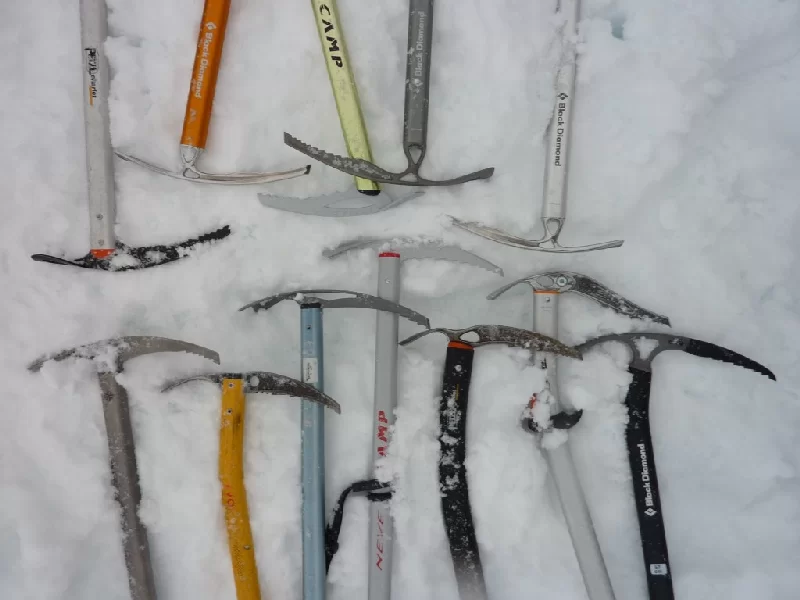
Introduction:
Ice axes are essential tools for mountaineers, ice climbers, and those venturing into snowy and icy terrains. These versatile implements provide stability, balance, and safety in challenging conditions. However, with a wide range of options available, selecting the right ice axe can be a daunting task. In this blog post, we’ll guide you through the essential factors to consider when choosing the perfect ice axe for your icy adventures.
- Type of Ice Axe:
There are primarily two types of ice axes: mountaineering ice axes and technical ice axes. Mountaineering ice axes are versatile tools suitable for general mountaineering, glacier travel, and moderate snow slopes. Technical ice axes, on the other hand, are designed for more challenging ice climbing and steep terrain. Determine your intended use and select the appropriate type of ice axe accordingly. - Length:
The length of your ice axe is crucial for proper functionality and safety. Mountaineering ice axes typically range from 60 to 75 centimeters, while technical ice axes are shorter, ranging from 50 to 60 centimeters. Consider the type of terrain you’ll be encountering and choose an ice axe length that allows for secure self-arrest techniques and efficient ice climbing. - Shaft Material:
Ice axe shafts are typically made from aluminum or carbon fiber. Aluminum shafts are durable, affordable, and suitable for most mountaineering activities. Carbon fiber shafts are lighter and offer better vibration dampening, making them ideal for technical ice climbing. Consider your budget, intended use, and preference for weight when selecting the material for the ice axe shaft. - Pick Design:
The pick is the pointed end of the ice axe that provides grip and stability on ice. There are two main pick designs: classic and reverse. Classic picks have a slight curve and are suitable for general mountaineering purposes. Reverse picks have a more aggressive curve and are better suited for technical ice climbing. Choose a pick design that matches your intended activities and provides the necessary functionality for your specific needs. - Adze or Hammer:
The head of the ice axe can feature either an adze or a hammer. An adze is a flat, shovel-like blade used for chopping steps in ice or snow. A hammer, on the other hand, has a flat surface for pounding pitons or other hardware during technical climbs. Consider the type of routes you’ll be tackling and choose an ice axe with the appropriate head attachment for your specific requirements. - Grip:
A comfortable and secure grip is essential for maintaining control and preventing hand fatigue during prolonged use. Look for an ice axe with a comfortable, ergonomic grip that fits your hand size. Some grips feature rubber or thermoplastic materials for enhanced grip and insulation, while others have grooves or ridges for better hand placement. Test the grip in person, if possible, to ensure a comfortable fit. - Leash or Leashless:
Leashes are used to attach the ice axe to your wrist, preventing accidental loss in case of a fall. Traditional leashes provide added security but can restrict hand movement. Leashless systems, on the other hand, offer more freedom of movement but require additional skill and confidence. Consider your level of experience, personal preference, and comfort when deciding between a leash or leashless system. - Brand Reputation and Reviews:
Researching reputable brands and reading reviews from experienced climbers can provide valuable insights into the performance, durability, and reliability of ice axes. Look for brands known for their quality craftsmanship, reliable customer service, and positive customer feedback. Authentic user experiences can help you make an informed decision and find an ice axe that meets your specific requirements.
Conclusion:
Choosing the right ice axe requires careful consideration of factors such as type, length, shaft material, pick design, head attachment, grip, leash options, and brand reputation. By assessing your intended activities, skill level, and personal preferences, you can find an ice axe that provides the necessary functionality, stability, and safety for your icy adventures. Invest in a high-quality ice axe that will accompany you on challenging climbs, ensuring your confidence and success in icy terrains. Stay safe and enjoy the thrill of conquering frozen landscapes.



